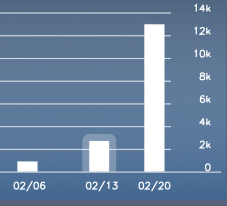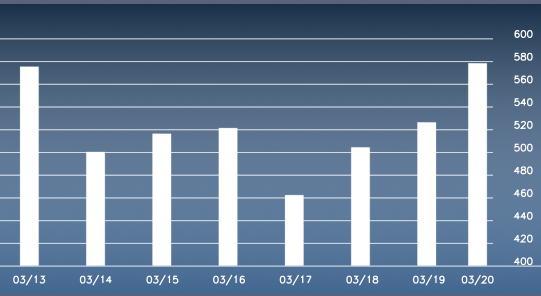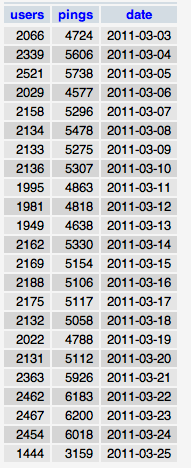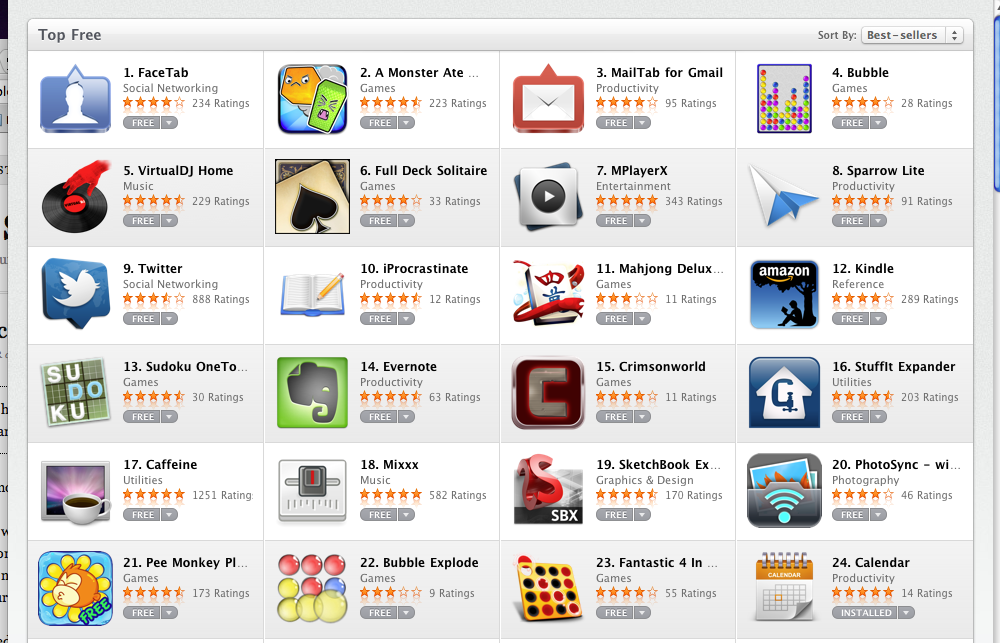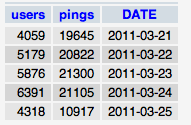Back in the end of March, I posted about successful completion of Phase 1. We had released two very successful products: Groups and Calendar, and they were being used by 26,000 times a day 7,500 people. Two months later, our numbers have doubled: every day now, they’re used 49,000 times by 20,000 people. How do we know? We programmed our apps to ping the server every time they’re opened, so we can analyze usage and improve user engagement.
Here is the overview from the last 10 days, if you’re interested:
mysql> SELECT DATE(time_ping) day, COUNT(DISTINCT udid) users, COUNT(1) pings
-> FROM calendar_ping WHERE time_ping >= "2011-05-01" GROUP BY day;
+------------+-------+-------+
| day | users | pings |
+------------+-------+-------+
| 2011-05-28 | 12944 | 27429 |
| 2011-05-29 | 14214 | 30504 |
| 2011-05-30 | 16323 | 36986 |
| 2011-05-31 | 17021 | 39326 |
| 2011-06-01 | 17023 | 39488 |
| 2011-06-02 | 16669 | 39085 |
| 2011-06-03 | 15802 | 36066 |
| 2011-06-04 | 13889 | 30173 |
| 2011-06-05 | 15245 | 34086 |
| 2011-06-06 | 17645 | 39671 |
+------------+-------+-------+
37 rows in set (3 min 59.63 sec)
mysql> SELECT DATE(time_created) day, COUNT(DISTINCT udid) users, COUNT(1) pings
-> FROM groups_ping WHERE time_created >= "2011-05-01" GROUP BY day;
+------------+-------+-------+
| day | users | pings |
+------------+-------+-------+
| 2011-05-28 | 4047 | 9418 |
| 2011-05-29 | 3901 | 9379 |
| 2011-05-30 | 4213 | 9653 |
| 2011-05-31 | 4714 | 11118 |
| 2011-06-01 | 4754 | 11298 |
| 2011-06-02 | 4628 | 11071 |
| 2011-06-03 | 4644 | 11213 |
| 2011-06-04 | 4102 | 9566 |
| 2011-06-05 | 4189 | 9911 |
| 2011-06-06 | 4119 | 9514 |
+------------+-------+-------+
Improvements
Since then, we’ve been working hard on our next phase — increasing user engagement, improving the user experience, and launching revenue streams.
One of the problems that you can see above is that there is a high churn rate. As of this writing, we have had roughly 100k downloads of Groups and 100k downloads of Calendar. While it’s true that every day, our apps are being used by 1 in 10 users who have ever downloaded it, we should do better. What about the other 9/10 of users? Well, we got a partial answer when we checked out our updates. The Groups app was updated on May 8th, and this led to the following chart:
Counting the number of people who upgrade gives us a pretty good estimate of how many people still have the app after they’ve installed it. By May 8th, we had around 80,000 users, and 20,000 users kept the app.
So our user retention rate for Groups was pretty okay. 1 out of 4 people kept our app and got the new upgrade when it came out. Our user engagement was less impressive — they used our app less than once every two days.
Calendar was doing much better. It was also downloaded by around 100,000 people, but it was being used three times as much. It actually became sort of a running game on the team to see which app would outdo the other. When Groups became free, it quickly started catching up to Calendar in terms of downloads, but its user engagement was still lagging behind.
Analytics
Thanks to our pings, we had a whole lot of data to look at. Our first idea was to check out how many users who fired up the app wound up using it on day 2, day 3, and days 7, 14 and 21. We found that most people who kept the app until day 2 liked it and continued using it. The problem, then, was with the new users. The app was not easy enough to start using or not compelling enough.
We knew that by adding social features later, we could increase user engagement, but this wasn’t a day-to-day user engagement problem. This was an issue that called for improving the first impression that our app made with users.
What do users want?
So we spoke with our users. Every day, we’d receive several support emails from Groups users. We decided to add a “PS:” to each email, asking them how they easy they found Groups to engage with when they first launched. Turned out, a lot of people had trouble navigating the interface — especially those who weren’t very tech savvy or just got their iPhone recently. Additionally, we felt that if the user didn’t make any groups, they wouldn’t find the app very useful as a contact manager.
The answer was clear — make a tutorial. So one of the things we added to Groups 1.6, our latest version, is a tutorial that you can launch if you haven’t made any groups yet. It walked you through the major 3 or 4 screens of the app, and showed you the main things you can do with it. We just submitted it to Apple, and once we have some data, I will write about whether that made a difference.
Poking Around
The current phase we’re in is all about metrics. If we are going to improve something, we have to be able to measure it. So we’re building tools to better analyze our user engagement, user retention, and user ramp-up metrics from the data we’ve been getting. As far as revenue streams, that’s pretty straightforward. Each in-app purchase is roughly independent of another, so the metric is how much revenue each one is bringing in every day.
Profitability
One of the other things we started working on is becoming profitable. If we will bring in more money than our burn rate, we are able to sustain our business indefinitely. This is a good position to be in when negotiating a valuation for the next round of funding in your company. You can sit back and focus on growing the value of your company, and take investment only if it makes sense, rather than out of fear that you’ll run out of money.
Later this month we’ll be releasing a major product: Calendar Pro. Unlike Calendar, it will be a paid app, probably around $1.99 , and in many ways it will be far beyond the various calendar apps that are selling right now for $15 or more. It will have things like:
- Google and Facebook syncing
- Weather forecasts
- Beautiful calendar views and backgrounds
- Community managed collections of backgrounds
- Ability to add events just by typing the information
We are looking to see if it makes sense to add any in-app purchases, as they were just announced at the WWDC earlier today. Anyway, we have some plans with this calendar app, but we aren’t going to reveal them just yet.
Next Steps
While our team is working on Groups and Calendar, we’ve had a couple other projects in the works. The team has grown to about 7 people, some working part-time, others full time. I’ve been busy coding, working on a scalable architecture for what is coming. I had said to myself I won’t code much anymore, but this particular thing I’m working on is very important.
Stage 3 will be all about viral applications. Only after we tweak the user engagement and user satisfaction, and we are satisfied with our metrics, will we add viral features. We are lucky that our apps have great discoverability, and that many our users stick around and love them and keep using them. So we can take our time and get things right before continuing.
But before we dare make something viral, we need to scale. I will talk about our scaling architecture in a future post. It is quite different from the typical stuff you find on highscalability.com . What I am working on won’t just be scalable, but distributed.
In short, there are fun things ahead. Right now, we are just working hard to prepare.

 Get blog updates
Get blog updates


